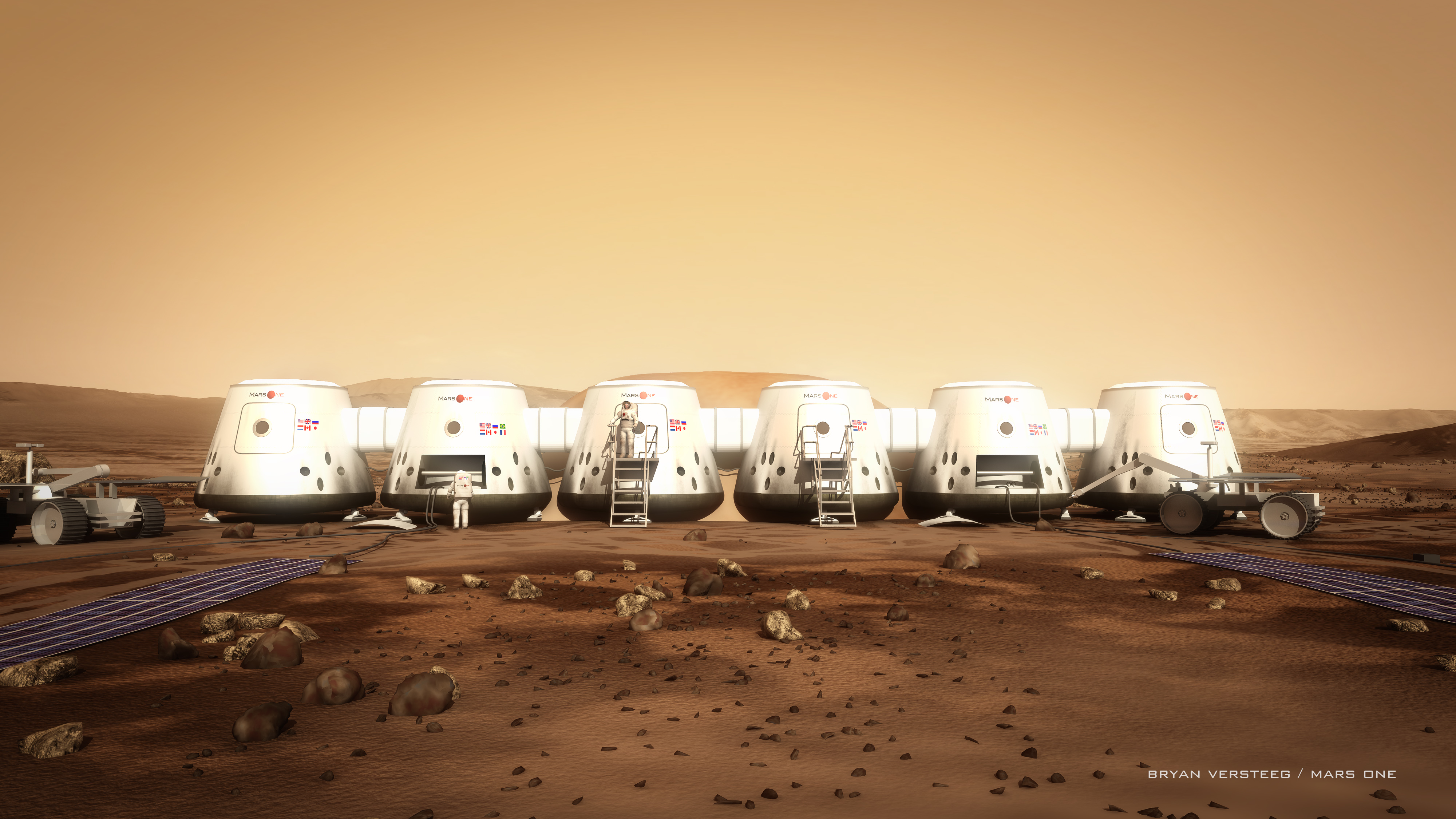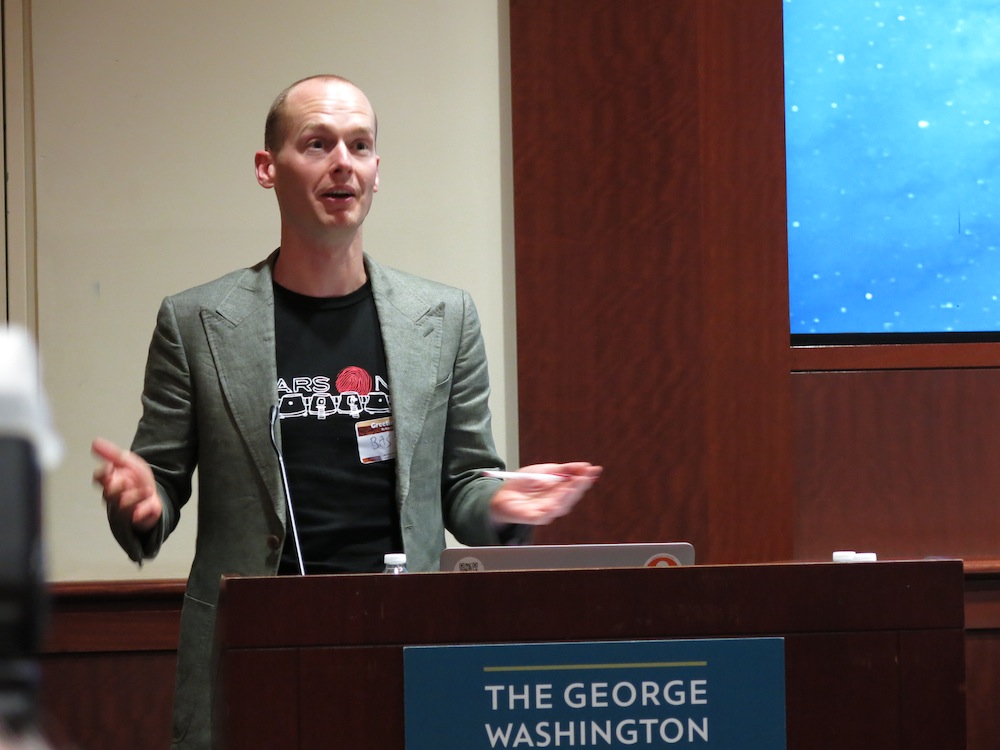Life on Mars: How a One-Way Martian Colony Project Could Work

LONDON — It's a one-way ticket, but don't worry: You'll live there longer than back home on Earth, says Bas Lansdorp. After all, on Mars you can't get hit by a car. And everything you'll eat will be organic — no pesticides, just fertilizer made from, well, recycled human waste.
As he addresses a room full of entrepreneurs, Lansdorp — founder of the Mars One colony project—looks as excited as a child. He is here at a recent International Space Commerce summit to promote his out-of-this-world idea, a one-way trip to the Red Planet, and possibly spark the interest of investors.
"There's no good answer to the question why exactly we want to go to Mars. But it will happen because exploration is what we humans do," Lansdorp says enthusiastically. [Photos: How Mars One Wants to Colonize the Red Planet]

Wanted: Mars colonists
The audience of suited-up men and women watches Landsorp speak, every now and then a sarcastic question pops up. "And have you thought about space radiation?" asked one listener.
Lansdorp has. He explained that the water the crews will carry to Mars will serve as shielding against deadly solar particles and cosmic rays. And once on the Red Planet, the habitat's roof will have some two meters of Martian soil for protection. You'll just have to make sure not to wander outside too much and you'll be okay. [Red Planet or Bust: 5 Manned Mars Mission Ideas]
Lansdorp has also thought through the entire time scale of what will happen when. More than 200,000 candidates have applied already, and sometime this month Landsdorp is expected to announce who's made it into the second round of selection.
Get the Space.com Newsletter
Breaking space news, the latest updates on rocket launches, skywatching events and more!
The first unmanned mission to pave the way will leave in 2016, followed by a first rover in 2018. This vehicle will start scouting for a perfect spot for the human outpost. In 2023, it will be joined by the very first Martians-to-be.
"What about you, will you go there?" asked another listener. It seems to be an unexpected question, which makes the Mars One founder pause momentarily.
"I started Mars One because I wanted to go, and I still want to go to Mars, but I had my first son a few weeks ago," Lansdorp answered. "But it's not even the main reason. I am just not that kind of person who can be locked up in a small room for 30 months with other people without hating each other."
"But I really hope I will be able to take my family to Mars one day," he added.

Martians forever
Lansdorp's vision evokes the image of a Ray Bradbury story "The Million-Year Picnic" in the book "The Martian Chronicles."
In the story, a father takes his family to Mars in the midst of war on Earth, duping them to believe it's only for a short vacation. When they arrive, he blows up the rocket and takes his wife and sons to meet other Martians. They go to a canal (on Bradbury's Mars, it is full of water), and see their reflection. That's the point — they are Martians. [Incredible Technology: How to Live on Mars]
Lansdorp's plan is very similar, except that in real life the Mars One crew won't have canals filled with water when they reach their destination. Nor will there be any breathable atmosphere. "The rovers will activate life support systems, they will feed them with Martian soil, which has ice crystals in it. This water will evaporate, and to make oxygen, we'll take nitrogen from the Martian atmosphere. We'll create an atmosphere," Lansdorp said.
That may work, technology permitting, and Lansdorp is sure it'll happen. But he is also certain that the Mars One colonists who leave Earth will be just like the folks in Bradbury's tale: They'll be Martians.
There may be more than 200,000 people happy to leave Earth (those who applied to the Mars One project online) but those that actually do make the trip, will never be coming back — even if they manage to build a rocket to return. "They will lose bone mass and muscle mass to such an extent that it will be extremely difficult for them to gain it back to survive a return trip to Earth and then the re-entry into the Earth’s atmosphere.
"They'll be Martians for the rest of their lives," Landsdorp said.

Live from Mars: Red Planet reality TV
To get his venture up and running, Lansdorp needs money.
Initially, he plans to finance it by turning the venture into a reality TV-like show, with people back home on Earth watching in real time the departure, the several months long trip, the arrival and the life at the first human outpost away from Earth.
So how much will it cost? About $6 billion to get the first four people on Mars and $4 billion for every crew that follows, says Lansdorp. But that's feasible, he added, because "the Olympic Games in London made about $4 billion in just three weeks of broadcasting, just because the world was watching. But this will be a lot bigger."
Of course, the world won't be watching forever, and at some point viewers' interest will dwindle — unless everything on the Red Planet starts going topsy-turvy. And if it doesn't, Lansdorp is certain that money will still be flooding in, to support the human outcasts far, far away.
"There is a small group of people in the world who have a lot of money," Lansdorp said with a cheeky smile. "There are 200 billionaires who can finance the trip from their net wealth. And if you have $6 billion in the bank, what are you going to do with it? You can buy a house, an island — but you'll still have $6 billion.
"Well, we offer you to buy immortality."
That may be well and good for Lansdorp's idealistic vision. After all, he isn't headed for Mars anytime soon.
But for those Mars One colonist hopefuls, assuming they make it, survive and even have kids, there may well be another reality TV show in a few decades from now: one about the first few Martians desperately trying to get back to Earth, wondering whether their parents made a wise choice.
One thing is certain: Those kids would have one heck of a story.
Follow Katia Moskvitch on Twitter @SciTech_Cat. Follow us @Spacedotcom. We're also on Facebook and Google+. Original article on SPACE.com.
Join our Space Forums to keep talking space on the latest missions, night sky and more! And if you have a news tip, correction or comment, let us know at: community@space.com.
Katia Moskvitch is a freelance science writer based in Switzerland currently serving as the head of communications for IBM Switzerland. She an award-winning writer who has covered astrophysics and other topics for Space.com, with her work also appearing in Quanta Magazine, Science, Wired, BBC News, Scientific American and The Economist among others.
In 2019, Katia was named European Science Journalist of the Year as well as British Science Journalist of the Year, and her book "Neutron Stars: The Quest to Understand the Zombies of the Cosmos" was published by Harvard University Press in September 2020. Katia holds a bachelor's degree in mechanical engineering from McGill University and master's degrees in journalism from the University of Western Ontario and in theoretical physics from King's College in London. She is fluent in English, French and Russian.









